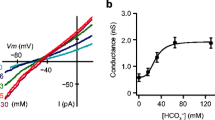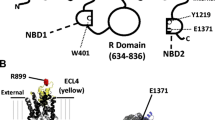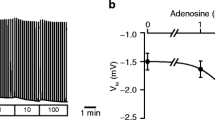Abstract
The patch-clamp technique and transepithelial current measurements in conjunction with analysis of transepithelial current noise were employed in order to clarify the role of the outwardly rectifying, depolarization-induced Cl− channel (ORDIC) during cAMP-mediated Cl− secretion in HT-29/B6 cells. Confluent monolayers growing on permeable supports were used in order to ensure the apical location of measured Cl− channels. The ORDIC needed to be activated by excision and/or depolarization, and was found in both cAMP-stimulated and non-stimulated cells. Both 5-nitro-2-(3-phenylpropylamino)-benzoate (NPPB) and 4,4′-dinitro-2,2′-stilbenedisulphonate (DNDS) induced fast flickery-type blocks of the ORDIC at low, micromolar blocker concentrations and were used as a probe for ORDIC. However, these substances were ineffective in blocking transepithelial forskolin-induced Cl− secretion of monolayers in Ussing chambers. No inhibitory effect at all was detected for DNDS up to 1 mmol/l. NPPB blocked the ORDIC at low concentrations (IC50=0.5±0.3 μmol/l) by reducing its open probability, but NPPB did not block forskolin-induced Cl− secretion unless high concentrations were used (IC50=240±10 μmol/l). In order to exclude effects of NPPB other than on the apical Cl− channel, trans-epithelial measurements were performed in basolaterally amphotericin-permeabilized, forskolin-stimulated preparations, and a serosal-to-mucosal Cl− gradient was applied as a driving force. Under these conditions, NPPB's inhibitory effects were also very small. Noise analysis of this gradient-driven Cl− current showed a very-low-frequency Lorentzian noise component (f c=1.4±0.2 Hz), which was not compatible with Lorentzians predicted from single-channel gating of ORDIC. As revealed from fura-2 fluorescence measurements, forskolin-stimulated Cl− secretion occurred in the absence of changes in intracellular Ca2+. Thus, we conclude that there is an apical Cl− channel in HT-29/B6 that is activated through the cAMP-mediated pathway and is insensitive to NPPB and DNDS, and the kinetics of which are incompatible with ORDIC kinetics. Therefore, despite its prevalence in isolated patches and even in cell-attached recordings, the ORDIC appears not to be involved in cAMP-mediated Cl− secretion by HT-29/B6 cells. From noise analysis, a very-small-conductance (probably below 1 pS), slow-gating Cl− channel was calculated as the conductive site in the apical membrane during forskolin stimulation.
Similar content being viewed by others
References
Breuer W, Skorecki KL (1989) Inhibition of PGE2 synthesis by a blocker of epithelial chloride channels. Biochem Biophys Res Commun 163:398–405
Bridges RJ, Worrell RT, Frizzell RA, Benos DJ (1989) Stilbene disulfonate blockade of colonic secretory Cl− channels in planar lipid bilayers. Am J Physiol 256:C902–912
Colquhoun D, Sigworth FJ (1983) Fitting and statistical analysis of single channel records. In: Sakmann B and Neher E (eds) Single channel recording. Plenum, New York, pp 191–263
Cunningham SW, Worrell RT, Benos DJ, Frizzell RA (1992) cAMP-stimulated ion currents in Xenopus oocytes expressing CFTR cRNA. Am J Physiol 262, C783-C788
Dalemans W, Barbry P, Champigny G, Jallat S, Dott K, Dreyer D, Crystal RG, Pavirani A, Lecocq J-P, Lazdunski M (1991) Altered chloride ion channel kinetics associated with the ΔF508 cystic fibrosis mutation. Nature 354:526–528
DeWolf I, Van Driessche W (1986) Voltage-dependent Ba2+ block of K+ channels in the apical membrane of frog skin. Am J Physiol 251:C696–706
Diener M, Rummel W (1989) Actions of the Cl− channel blocker NPPB on absorptive and secretory transport processes of Na+ and Cl− in rat descendent colon. Acta Physiol Scand 137:215–222
Dreinhöfer J, Gögelein H, Greger R (1988) Blocking kinetics of Cl− channels in colonic carcinoma cells (HT-29) as revealed by 5-nitro-2-(3-phenylpropylamino)bencoic acid (NPPB). Biochim Biophys Acta 946:135–142
Fischer H, Van Driessche W, Clauss W (1989) Evidence for apical sodium channels in frog lung epithelial cells. Am J Physiol 256:C764-C771
Fischer H, Kromer W, Clauss W (1991) Two types of chloride channels in hen colon epithelial cells identified by patch clamp experiments. J Comp Physiol B 161:333–338
Fischer H, Illek B, Negulescu PA, Clauss W, Machen TE (1992) Carbachol-activated calcium entry into HT-29 cells is regulated by both membrane potential and cell volume. Proc Natl Acad Sci USA 89:1438–1442
Frizzell RA, Rechkemmer G, Shoemaker RL (1986) Altered regulation of airway epithelial cell chloride channels in cystic fibrosis. Science 233:558–560
Gögelein H (1988) Chloride channels in epithelia. Biochim Biophys Acta 947:521–537
Gray MA, Harris A, Coleman L, Greenwell JR, Argent BE (1989) Two types of chloride channel on duct cells cultured from human fetal pancreas. Am J Physiol 257:C240-C251
Greger R, Schlatter E, Gögelein H (1985) Cl− channels in the apical membrane of the rectal gland “induced” by cAMP. Pflügers Arch 403:446–448
Greger R, Nitschke RB, Lohrmann E, Burhoff I, Hropot M, Englert HC, Lang HJ (1991) Effects of arylaminobenzoate-type chloride channel blockers on equivalent short-circuit current in rabbit colon. Pflügers Arch 419:190–196
Halm DR, Rechkemmer GR, Schoumacher RA, Frizzell RA (1988) Apical membrane chloride channels in a colonic cell line activated by secretory agonists. Am J Physiol 254:C505-C511
Hamill OP, Marty A, Neher E, Sakman B (1981) Improved patch clamp technique for high resolution current recordings from cells and cell-free membrane patches. Pflügers Arch 391:85–100
Hayslett JP, Gögelein H, Kunzelmann K, Greger R (1987) Characteristics of apical chloride channels in human colon cells (HT-29). Pflügers Arch 410:487–494
Illek B, Fischer H, Kreusel KM, Hegel U, Clauss W (1992) Volumesensitive K+ channels in the basolateral membrane of HT-29/B6 monolayers blocked by lidocaine, quinidine, NPPB and barium. Am J Physiol, in press
Keeling DJ, Taylor AG, Smith PL (1991) Effects of NPPB on the chloride transport in intestinal tissues and the T84 cell line. Biochim Biophys Acta 1115:42–48
Kreusel KM, Fromm M, Schultzke JD, Hegel U (1991) Cl− secretion in epithelial monolayers of mucus-forming human colon cells (HT-29/B6). Am J Physiol 261:C754-C582
Kunzelmann K, Grolik M, Kubitz R, Greger R (1992) Conductance properties and cAMP dependent activation of small conductance Cl− channels in HT-29 colon carcinoma cells. Pflügers Arch, in press
Li M, McCann JD, Liedtke CM, Nairn AC, Greengard P, Welsh MJ (1988) Cyclic-AMP-dependent protein kinase opens chloride channels in normal but not cystic fibrosis airway epithelium. Nature 331:358–360
Lukacs GL, Nanda A, Rotstein OD, Grinstein S (1991) The chloride channel blocker NPPB uncouples mitochondria and increases the proton permeability of the plasma membrane in phagocytic cells. FEBS Lett 288:17–20
Marty A, Tau YP, Trautwein A (1984) Three types of calcium-activated Cl− channels in rat lacrimal glands. J Physiol (Lond) 357:293–325
Reinach P, Schoen HF (1990) NPPB inhibits the basolateral membrane K+ conductance in the isolated bullfrog cornea. Biochim Biophys Acta 1026:13–20
Schoumacher RA, Shoemaker RL, Halm DR, Tallant EA, Wallace RW, Frizzel RA (1987) Phosphorylation fails to activate chloride channels from cystic fibrosis airway cells. Nature 330:752–754
Sigworth FJ, Sine S (1987) Data transformation for improved display and fitting of single channel dwell time histograms. Biophys J 52:1047–1054
Singh AK, Afink GB, Venglarik CJ, Wang R, Bridges RJ (1991) Colonic Cl channel blockade by three classes of compounds. Am J Physiol 260:C51-C63
Solc CK, Wine JJ (1991) Swelling-induced and depolarization-induced Cl− channels in normal and cystic fibrosis epithelial cells. Am J Physiol 261:C658-C674
Tabcharani JA, Hanrahan JW (1991) On the activation of outwardly rectifying anion channels in excised patches. Am J Physiol 261:G992-G999
Tabcharani JA, Chang XB, Riordan JR, Hanrahan JW (1991) Phosphorylation-regulated Cl− channel in CHO cells stably expressing the cystic fibrosis gene. Nature 352:628–631
Tilmann M, Kunzelmann K, Fröbe U, Cabanchik I, Lang HJ, Englert HC, Greger R (1991) Different types of blockers of the intermediate-conductance outwardly rectifying chloride channel in epithelia. Pflügers Arch 418:556–563
Wangemann P, Wittner M, DiStefano A, Englert HC, Lang HJ, Schlatter E, Greger R (1986) Cl−1 channel blockers in the thick ascending limb of the loop of henle. Structure-activity relationship. Pflügers Arch 407 [Suppl 2]:S128-S141
Author information
Authors and Affiliations
Rights and permissions
About this article
Cite this article
Fischer, H., Kreusel, K.M., Illek, B. et al. The outwardly rectifying Cl− channel is not involved in cAMP-mediated Cl− secretion in HT-29 cells: evidence for a very-low-conductance Cl− channel. Pflügers Arch 422, 159–167 (1992). https://doi.org/10.1007/BF00370415
Received:
Revised:
Accepted:
Issue Date:
DOI: https://doi.org/10.1007/BF00370415




